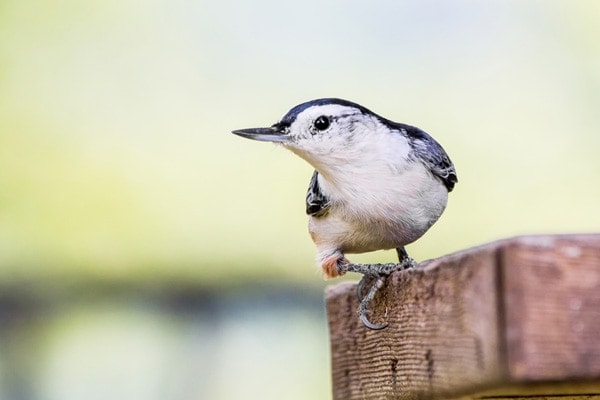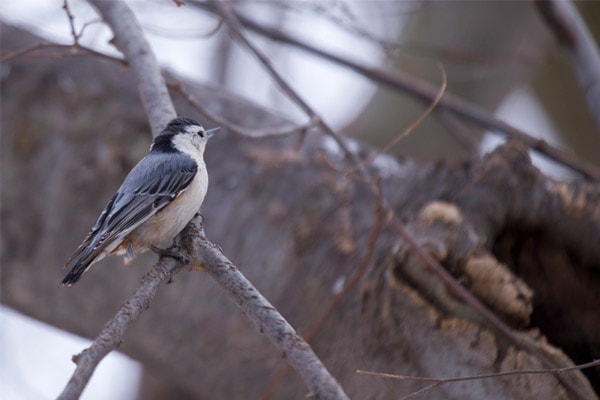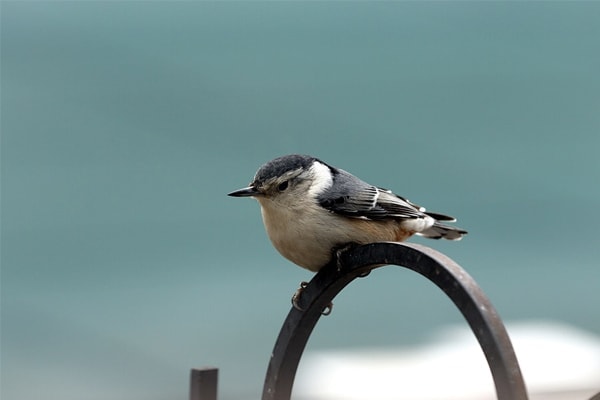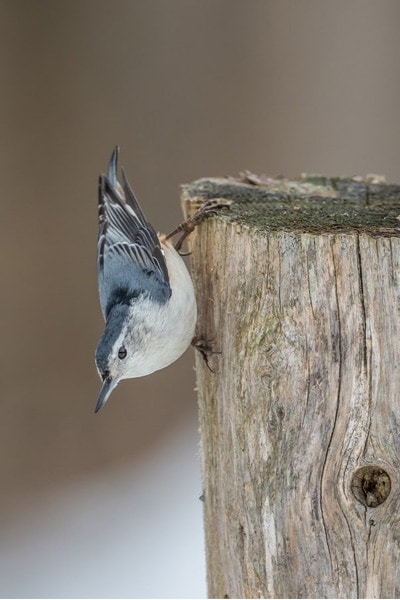 The White-breasted Nuthatch is a frequent visitor of bird feeders. They are easily identifiable with their clean black, white, and blue-gray color pattern that stays the same throughout the year. These birds are known to be small but agile and loud. And since they remain in the same territory throughout the year, you have a lot of time to enjoy seeing them every day.
The White-breasted Nuthatch is a frequent visitor of bird feeders. They are easily identifiable with their clean black, white, and blue-gray color pattern that stays the same throughout the year. These birds are known to be small but agile and loud. And since they remain in the same territory throughout the year, you have a lot of time to enjoy seeing them every day.
In this article, we are going to cover a wide variety of topics related to the White-breasted Nuthatch, such as:
- How to identify them
- How, when, and where they migrate
- Their diet
- How and where they nest
- And much more…
So, without any more delay…
Let’s jump right into it and learn more about the White-breasted Nuthatch.
White-breasted Nuthatch Facts
- Common Name: White-breasted Nuthatch
- Scientific Name: Sitta carolinensis
- Scientific Family: Sittidae
- Life Span: 2 years
- Size: 5.1 to 5.5 inches
- Wingspan: 7.9 to 10.6 inches
- Weight: 0.6 to 1.1 oz
- Conservation status: Least Concern
How To Identify A White-breasted Nuthatch
White-breasted Nuthatches are small-sized birds that are only about 5 inches in length. These birds have large heads with necks that are only slightly seen. You’ll also notice that they have short tails and a long, straight, grey-colored bill.
Overall, the birds are wearing a black to blue-gray plumage. You’ll notice that their crown up to their nape is black, the face and underparts are white, and their back down to the tail areas are blue-gray.
When in flight, you’ll also notice some reddish-brown colors on their undertail area. Their wings and upper tail also show some brown to black linings.
Differences Between Male & Female
 Male and female White-breasted Nuthatches generally look the same. However, it is noted that females appear to have a duller color than males. Their crowns appear to be gray instead of black.
Male and female White-breasted Nuthatches generally look the same. However, it is noted that females appear to have a duller color than males. Their crowns appear to be gray instead of black.
Differences In Summer Plumage vs Winter Plumage
Male and female White-breasted Nuthatches generally look the same. However, it is noted that females appear to have a duller color than males. Their crowns appear to be gray instead of black.
White-breasted Nuthatch Sounds
Where You’ll See White-breasted Nuthatches
White-breasted Nuthatches are widespread across North America. You’ll see them in some southern areas of Canada, across all of the United States, and down to central Mexico.
These are often found in mature deciduous forests or mixed deciduous and coniferous forests. They can also live in forest edges, side of rivers, parks, roads, clearings, and other open areas with large trees.
White-breasted Nuthatch Migration Patterns

photo credit: Chris Chow on Unsplash
White-breasted Nuthatches are resident birds, which means they stay in the same area all-year-round. There may be some movements for some birds, but it’s only for short distances. They always tend to stay within their breeding range.
Diet and Feeding Preferences
White-breasted Nuthatches eat both insects and seeds, but quantity would vary on the season.
During the breeding season, the birds would eat mainly insects, including beetle larvae, other beetles, ants, caterpillars, and even spiders. They would also eat a little portion of seeds and nuts, including acorns, sunflower seeds, and crops.
Once winter comes, food proportion varies greatly, with White-breasted Nuthatches eating around 60% of seeds in winter. They would also visit bird feeders for some sunflower seeds, suet, and peanut butter mixes.
Nesting Data
- Clutch Size: 5-9 eggs
- # of Broods: 1 brood
- Incubation Period: 13-14 days
- Nestling Period: 26 days
- Egg Description: Cream to pinkish-white with rusty, gray, or purple speckles
Nesting
White-breasted Nuthatches are monogamous birds, and pairs often stay together for the whole year. Sometimes, they remain together until their mate dies or disappears.
The breeding season often starts between early May and June, and nests are built in tree cavities or abandoned woodpecker holes. These birds also usually stay in elevations of 15 to 60 feet above the ground.
If the hole they find is a bit small, the birds may enlarge this. But never do they excavate a hole entirely.
Once a site is chosen, females are the ones who build the nest. They would start by putting some fur, bark, and dirt on the nest cavity before building the nest. They would then use fine grass, thin barks, feathers, and other soft materials to create a cup-shaped nest.
White-breasted Nuthatch Behavior

photo credit: Skyler Ewing from Pexels
White-breasted Nuthatches can be easily identified by their impressive skill of climbing up and down the trunks of trees. Sometimes, they even walk sideways and around large branches. This is how they search for food on the cracks of the wood.
There are also occasions where they search for food on the ground. But these birds prefer to hop than walk. They also tend to store seeds and insects in their territory, hiding them under bark, moss, lichen, or snow.
As these birds are non-migratory, they would defend their territory all-year-round. They would chase fellow nuthatches away from their territory, and males are also dominant over females.
When the food supply is low in winter, the birds would sometimes fly to other areas, mostly in bird feeders and even joining other bird species.
Tips for Birdwatchers On How To Attract White-breasted Nuthatches
White-breasted Nuthatches are frequent visitors of bird feeders, which means they’re easy to attract. And since they stay in the same territory all-year-round, they would surely visit your backyard if they know there’s food there.
As these birds mainly eat insects, one thing you need to make sure of is that your backyard is insect-friendly. So, don’t use any insecticides or pesticides.
Other than that, try to hang some suet feeders and other types of feeders that you can fill with their favorite seeds and large nuts. Try to provide some shelter, too, if you want them to breed next to your home.
You can also set-up a birdbath for the birds’ water source.
Threats To The White-breasted Nuthatch

photo credit: Patrice Bouchard on Unsplash
White-breasted Nuthatches are widespread birds across North America, and their populations continue to increase. Because of this, they are considered a “least concern” in terms of conservation status.
However, since these birds mainly breed in dead or partially dead trees, cutting down dead wood may cause their population to fall. The birds also have several predators, including hawks, owls, woodpeckers, squirrels, and snakes.
Fun & Interesting Facts
- White-breasted Nuthatches are also called “upside-down” birds.
- They can climb up, down, and sometimes, sidewards on tree trunks.
- These birds would often store seeds but only keep them for a short amount of time. They would often eat these seeds within the day or immediately the following day.
- The oldest recorded White-breasted Nuthatch was nine years and nine months old.
Explore More Species in This Family
- Red-breasted Nuthatch
- Pygmy Nuthatch
- Brown-headed Nuthatch
The post White-breasted Nuthatch: Bird Identification, Habits, Facts, Nesting appeared first on BirdInformer.com.
from BirdInformer.com https://ift.tt/3d0fuzK

No comments:
Post a Comment